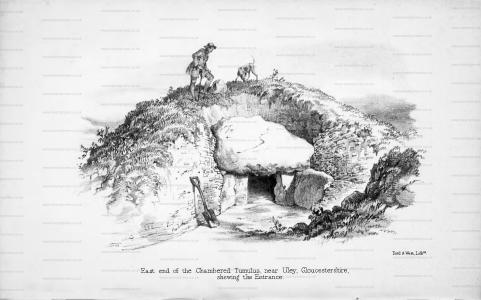Biography of John Thurnam 1810-1873
John Thurnam 1810-1873 is in Antiquaries.
Amesbury 42 Long Barrow [Map] is a Long Barrow at the end of the Stonehenge Greater Cursus. It was noted by William Stukeley (age 35) in 1723 and Richard Colt Hoare 2nd Baronet (age 51) in 1810. It was excavated by John Thurnam in 1810 who recovered an Ox Skull and discovered secondary inhumations. The barrow is now levelled.
On 28 Dec 1810 John Thurnam was born.
John Thurnam 1854. Description Of A Chambered Tumulus, Near Uley [Uley Barrow aka Hetty Pegler's Tump [Map]], Gloucestershire by John Thurnam (age 43). 1854.

Wiltshire Archaeological Magazine 1856 V3 Pages 67-86. On the Barrow of Lanhill [Map] near Chippenham. with remarks on the site of, and the events connected with The Battles of Cynuit and Ethandun, A.D. 878 By John Thurnam (age 45), M.D. F.S.A.
Wiltshire Archaeological Magazine 1856 V3 Pages 164-177. On a Cromlech-tumulus called Lugbury [Map], near Littleton Drew by John Thurnam (age 45), M.D., F.S.A.
Wiltshire Archaeological Magazine 1859 V6 Pages 317-336. Examination of the Barrows on the South Downs of North Wiltshire in 1853-1857 by John Thurnam (age 48), M.D., F.S.A.
Archaeologia Volume 38 1883 Section XXVII. On The Examination Of A Chambered Long Barrow At West Kennet [Map], Wiltshire. By John Thurnam (age 49). Read 15th March, 1860.
Wiltshire Archaeological Magazine 1860 V7 Pages 321-333. On Wayland's Smithy [Map], and on the Traditions connected with it by John Thurnam (age 51), M.D., F.S.A.
Nympsfield Skulls. Report on the Skulls from the Tumulus at Nympsfield [Map]. By John Thurnam (age 54), M.D., F.S.A.
Wiltshire Archaeological Magazine 1866 V10 Pages 130-135. Examination of a Chambered Long Barrow [West Kennet Long Barrow [Map]], at West Kennet, Wiltshire. By John Thurnam (age 55).
Wiltshire Archaeological Magazine 1868 V11 Pages 40-49. On Four Lozenge Shaped Flint Javelin Heads from an Oval Barrow near Stonehenge; and On the Leaf Shaped Type of Flint Arrow-Head and its Connection with Long Barrows by John Thurnam (age 57), M.D., F.S.A.
Wiltshire Archaeological Magazine 1872 V13 Pages 339-342. On Long Barrows and Round Barrows by John Thurnam (age 61), Esq, M.D., F.S.A. Report of an Address delivered on Bratton Down, during an Execursion of the Society, August 8th, 1872.
On 24 Sep 1873 John Thurnam (age 62) died.
Adam's Grave [Map] is a Severn Cotswolds type chambered. The chamber was made of sarsen stones. It contained partial human skeletons. An leaf shaped arrowhead was also recovered. The tomb was 70m long, around 7m high with ditches on either side. It was partially excavated by John Thurnam in 1860.
Adam's Grave [Map] Historic England Entry:
The monument includes Adam's Grave, a long barrow set on a promontory above a steep south-facing escarpment. It survives as a substantial earthwork orientated NW-SE and is trapezoid in plan. The barrow mound is 70m long, c.7m high and survives to an average width of 20m. Flanking ditches, from which material used to construct the mound was quarried, run parallel to the north and south sides of the mound. These are 7m wide and up to 2m deep. The south-east end of the monument was partially excavated by Thurnham in 1860. Finds included part of a chamber formed from large sarsen stones, traces of human skeletons and a leaf shaped arrowhead. Numerous other long barrows are known in the area while a broadly contemporary enclosure at Knap Hill [Map] is situated on an neighbouring promontory.
East Kennet Long Barrow [Map] is a Severn Cotswolds type Chambered Tomb.
The monument includes a long barrow set below the crest of a gentle north- east facing slope. It survives as a substantial earthwork orientated north- west/south-east and is broadly rectangular in plan. The barrow mound is flat topped. It survives to 106m long, 50m wide and stands to a height of c.8m at the south-east end and 4m at the north-west end. Flanking ditches, from which material was quarried during the construction of the monument, run parallel to the south-west and north-east sides of the mound and survive to a width of c.5m. These have become infilled over the years but survive as a low earthwork on the north-east side of the mound and as a buried feature to the south-west. The monument has been partially excavated, both by the Rev. M Connor in the 19th century and later by Thurnham. No details are known.
Archaeologia Volume 42 1869 Section IX. On Ancient British Barrows, especially those of Wiltshire and the adjoining Counties. (Part I. Long Barrows). By John Thurnam, Esq. M.D., F.S.A., Local Secretary for Wiltshire. Read December 12th, 1867; February 20th and 27th, 1868.